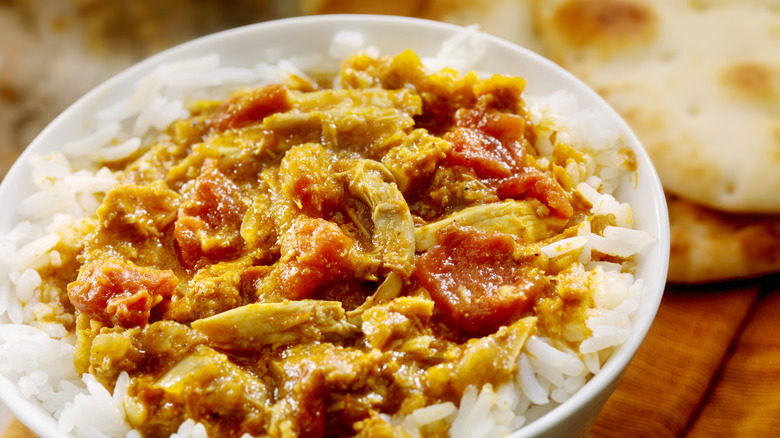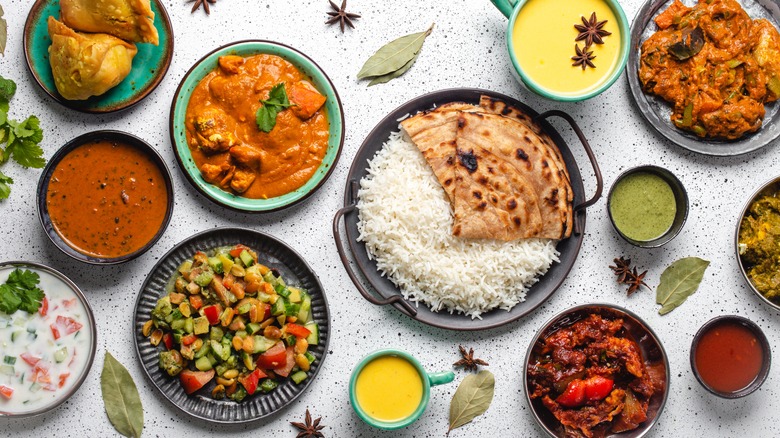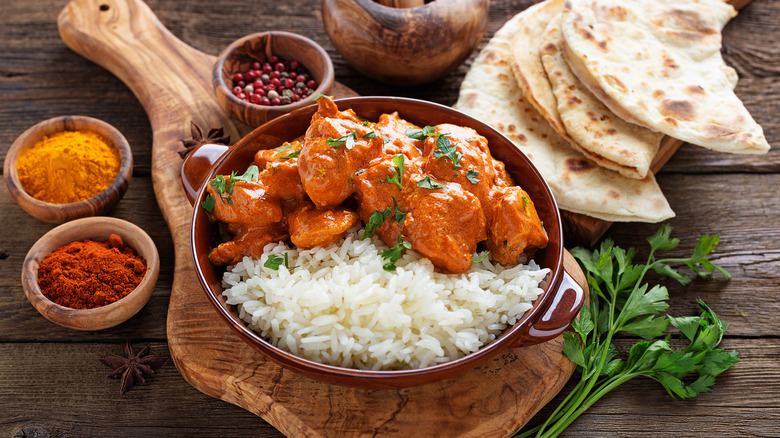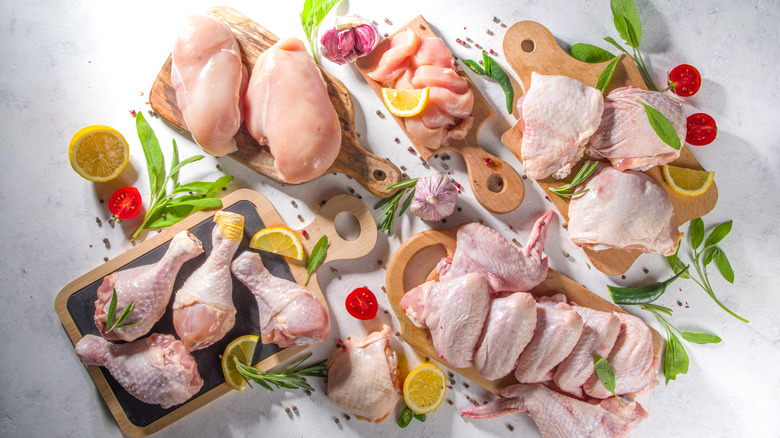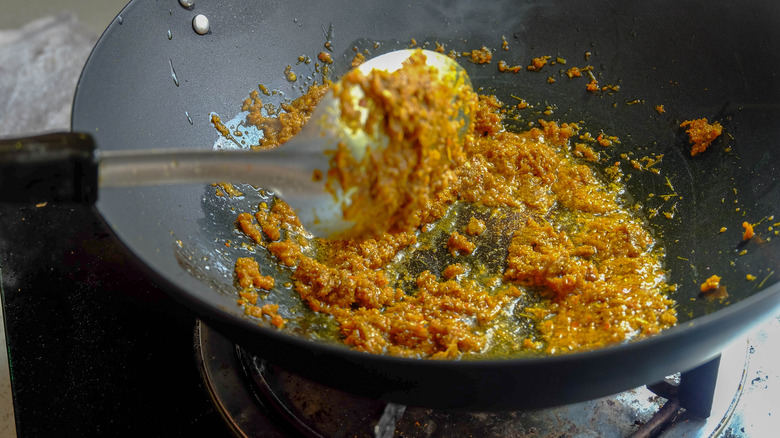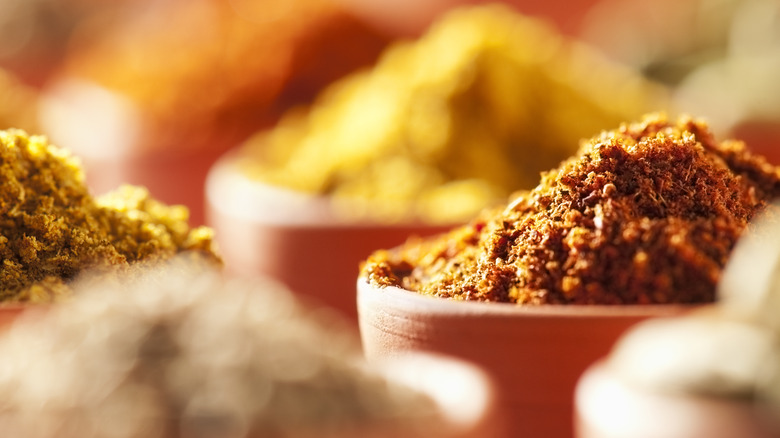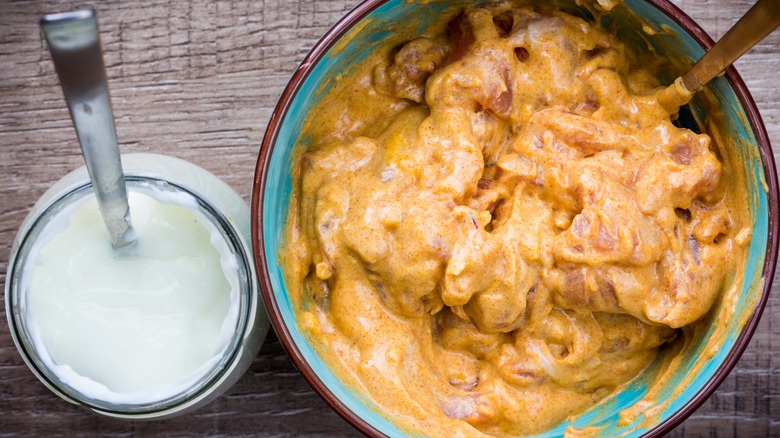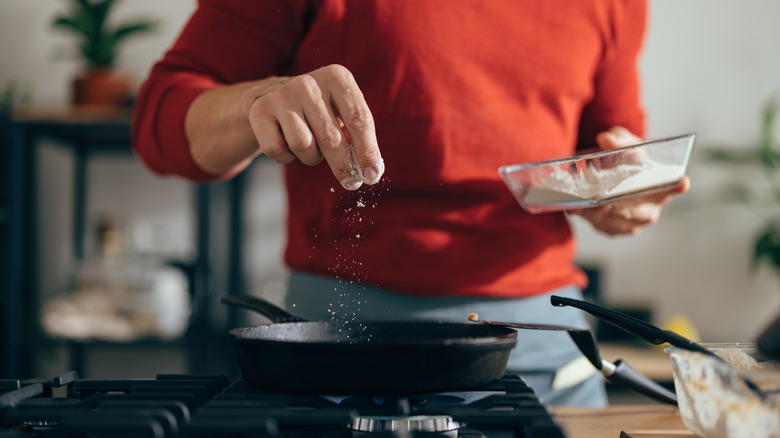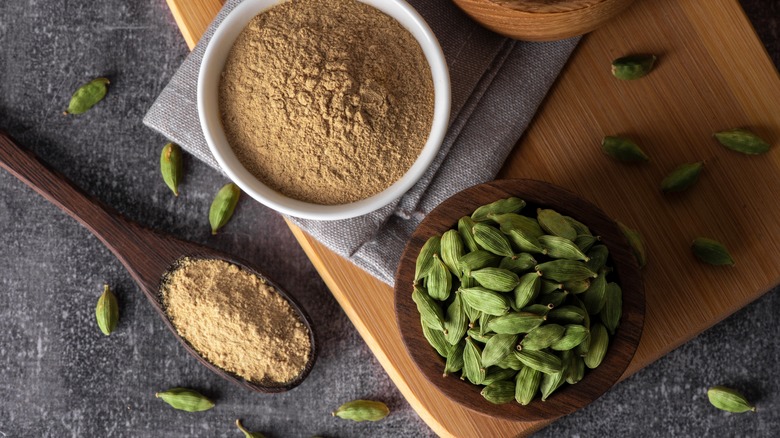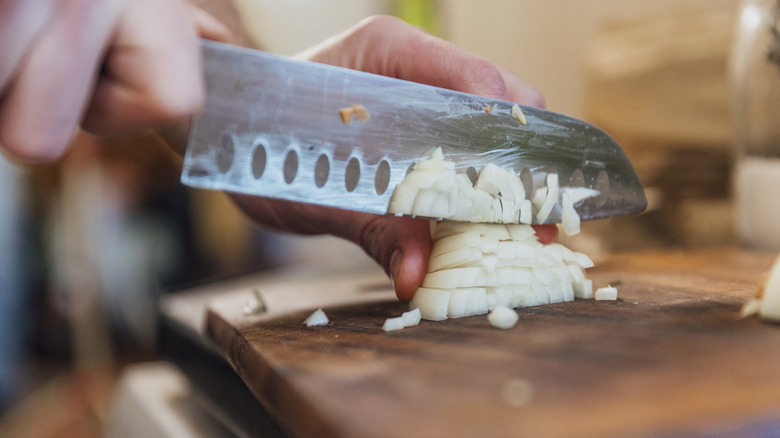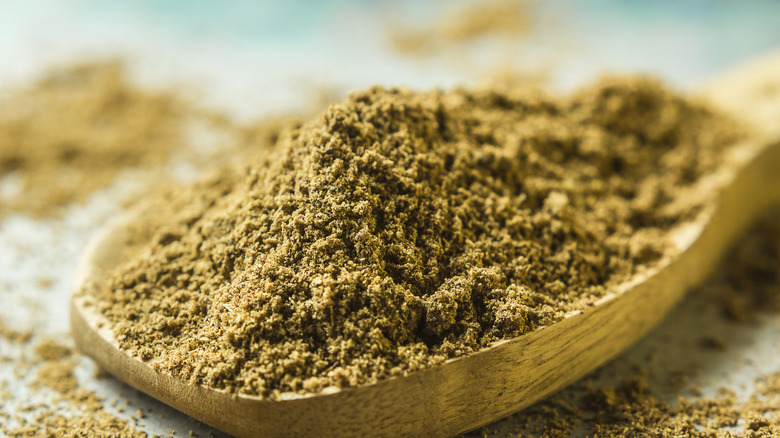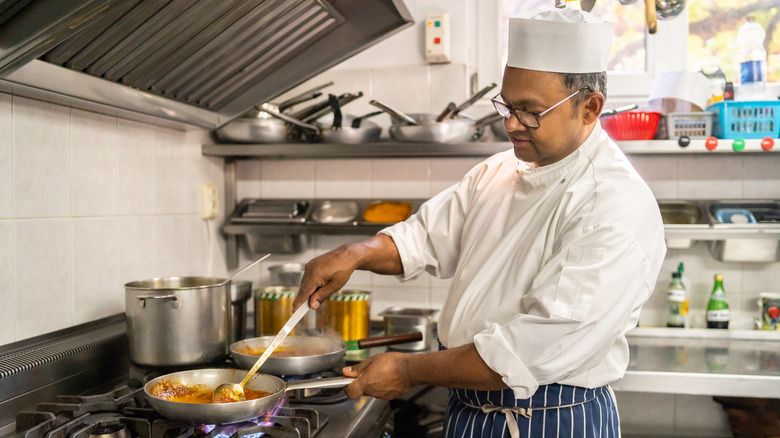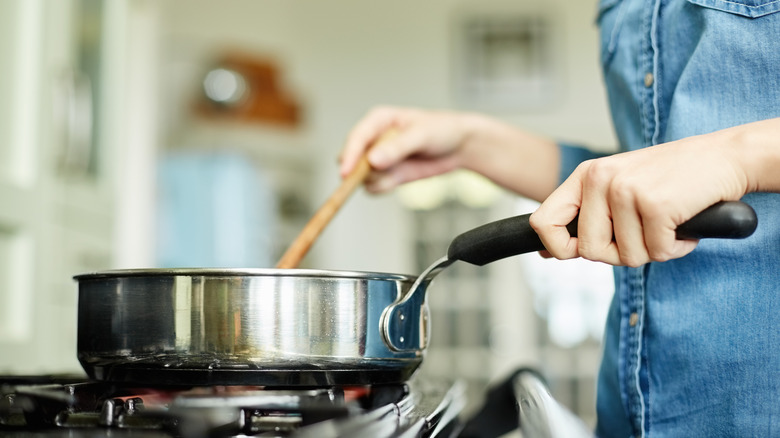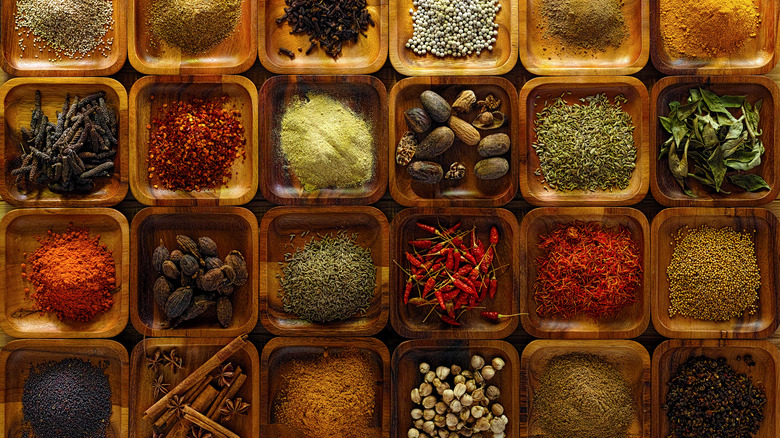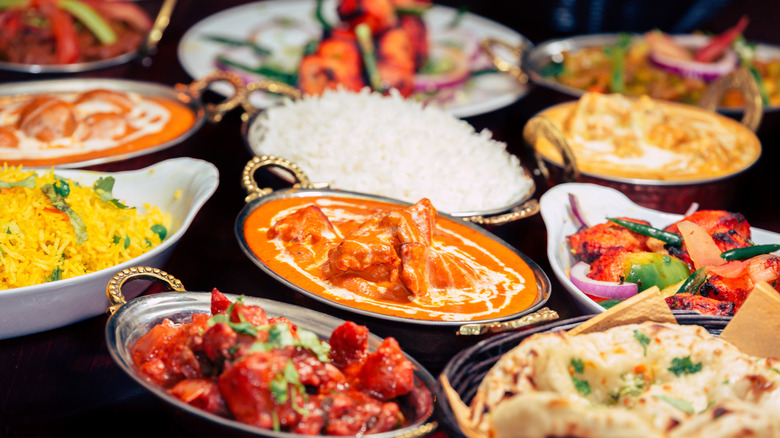14 Mistakes To Avoid When Cooking Chicken Tikka Masala
Ask people to name a curry dish and the most common answer is almost always going to be chicken tikka masala. It's a famous dish that has been delighting diners for around half a century. While a staple of many recipe books, there are several common mistakes people can make when cooking it. This is no surprise. A beautiful chicken tikka masala not only requires a wide range of top-quality ingredients but also patient preparation.
Many things can trip you up when you're trying to make an epic curry dish. It's easy to cook ingredients at the wrong time, take shortcuts, or even doubt your cooking ability. Here we'll navigate those pitfalls to ensure you can turn your run-of-the-mill tikka masala into one you can proudly show off to your family and friends. Not only will these tips help you with your chicken tikka masala, but they will power you with the knowledge to make delicious curries for years to come.
Thinking it's an authentic Indian dish
Are you looking to impress your friends by cooking an authentic Indian curry? If so, chicken tikka masala isn't for you. Many popular curry dishes are British inventions, and tikka masala is no different. While chicken tikka masala has mysterious origins, the most commonly held belief is that it was invented by a Pakistani man called Ali Ahmed Aslam in the 1970s. He was working in a Glasgow restaurant when a customer complained about his dry chicken, and therefore he created a delicious gravy to go with it. Aslam sadly died in 2022, but his impact on British food culture will be forever remembered.
Should the fact it's not an authentic Indian dish put you off? Absolutely not. It's the perfect entry point to curry making and can teach you a lot about how to use spices and customize a curry to your taste. Many recipes for the dish have a more Western approach which is a little simpler and easier to follow for novices. Once you master the chicken tikka masala, you can use it as the perfect stepping stone to either create your own curry or cook more authentic Indian dishes. Instead of being put off that you're not making an original Indian curry, revel in the fact you're making the national dish of the U.K.
Thinking there's a right way to do it
When it comes to the definition of chicken tikka masala, things actually become quite vague. Most describe it as marinated boneless chicken which is cooked in a spiced tomato sauce. It is traditionally cooked in a tandoor, but not many recipes will call for this.
So what does all this mean for your tikka masala? It means you don't need to fret about doing it wrong. If you read 100 chicken tikka masala recipes, they'll probably tell you to make it 100 different ways. For this dish, beauty is in the eye of the beholder and as long as you think it tastes good, you've done it right.
You shouldn't fear all of this variation but embrace it instead. As you become more comfortable with making tikka masala, you'll understand the impact of different spices and cooking methods. This will lead you on a journey of self-discovery where you'll end up with your perfect version of this famous dish. While that's true, there are cooking methods and ingredients that can help elevate your tikka masala
Only using chicken breast
There is nothing wrong with using chicken breast in your tikka masala. However, you should at least consider the benefits of using other cuts. For all its convenience, chicken breast has the mildest flavor of any part of a chicken. For those looking for the greatest depth of flavor, chicken thigh is the best cut of chicken for curry. Chicken tikka masala calls for boneless chicken, so you'll either need to buy your thighs that way or debone them yourself. It's worth the effort, as the darker parts of the chicken, such as the thighs and legs, are going to give you a deeper flavor.
Other cuts of meat don't quite work for a curry; wings and drumsticks don't have enough meat on them when removed from the bone. Thighs are your best option, but it's important to note that they take a little longer to cook than the breast. This is because they are both denser muscles and are higher in fat. But the extra time and effort needed for chicken thighs is worth it, as the meat will be more tender and juicier. When paired with a perfect marinade, you'll compliment your sauce with delicious chicken pieces.
Not making your own curry paste
If you lack confidence in cooking curries, then using store-bought curry paste is completely understandable. It will allow you to focus on perfecting the other parts of the dish and you can save making your own curry paste for another time. It's also perfectly understandable if you want to cut down on your cooking time as you just want a quick meal. But while there's no shame in using curry paste from a jar, it will never result in the tastiest curry. As with most things that come from a jar, you won't get the freshest flavors or that real depth of taste. Once you've learned how to make your own curry paste, then you'll never go back.
As we mentioned before, there is a huge variation in tikka masala recipes, and much of that variation comes from the different ways you can make curry paste. Not only will the exact ingredients change but also the quantity of those ingredients. As you become more adept at making curries, you'll learn how these ingredients affect your curry paste until you come up with a perfect combination. Once you do, you'll have your own unique paste recipe that you can replicate repeatedly.
Using low-quality ingredients
This is, of course, a mistake that you can make with any recipe. However, with chicken tikka masala, you'll be dealing with a long list of ingredients that all have a significant impact on the dish. If just one of those ingredients isn't the right quality, it can let the whole team down. The better the ingredients, the better the end product. Ideally, you want your spices, vegetables, and chicken to be as fresh as possible for the brightest flavor.
These days it's easy to get a wide range of precut or ground ingredients either frozen or in a jar. We'll pick garlic as an example here. Pre-minced garlic in a jar can be an excellent time-saver in your day-to-day cooking. However, there are downsides, as they need to use preservatives and it'll never taste as fresh. If you want to make the best possible curry base, you need to be using fresh garlic cloves. This is just one example, but the same could be said for your spices, onions, tomatoes, and more. Using high-quality ingredients will be the difference between a good and a great tikka masala.
Not marinating long enough
There are only a few absolute musts when it comes to chicken tikka masala, but marinating is one of them. Without this step, you'll just be eating chicken masala, as the marination is part of what turns regular chicken pieces into delicious tikka. You want those chicken pieces to absorb the marinade enough so that they lock in the flavor once cooked. But how much time should you let the mixture rest? Anywhere between 4 to 24 hours is ideal, as there are downsides to both under and over-marinating.
If you under-marinade, you're not giving the chicken enough time to absorb those flavors. But what if you've not got four hours? Thankfully even leaving the marinade for just 30 minutes will get some results, even though it's not ideal. A great tip for ultra-flavorful chicken, especially if you're short on time, is to pierce the chicken with a fork. This gives the mixture a better chance to get deeper into the chicken.
It's also possible to go the other way and leave chicken marinating for too long. Eventually, the acid in the mixture will start to break down the chicken and make it soft and mushy, which is why 24 hours is a good maximum limit. The best advice is to either make it the night before, or the morning of, the day you'll be making the meal.
Forgetting to add plenty of salt
If you're new to cooking curry then you'll be faced with plenty of seasonings and spices, many of which you may never have used before. However, one ingredient that you'll be very familiar with is boring old salt. You may be hesitant to use much salt as it's not one of the traditional Asian spices. A common mistake is thinking you should be using extra spices instead of salt to add more flavor. The reality is that salt isn't boring at all, and it's an important part of your chicken tikka masala. Trust us — if you go into any Indian restaurant, any curry you order is going to contain a lot of salt.
There are a few different types of salt you can use, with many modern curry chefs preferring to use kosher salt. This has a coarser texture that can help to season food more evenly and doesn't have the harsher taste of table salt. That being said, this is mainly down to personal preference, so don't worry if you only have table or sea salt. Worried about adding too much? There are many tips and tricks for removing excess salt, but perhaps the easiest method is to throw in some raw potatoes, which do a great job of absorbing that extra salinity.
Throwing in your spices before toasting them
Using pre-ground spices is another common shortcut. Again, there's nothing wrong with that if you don't have the time to spend hours preparing meals every day. While they can be a great time saver, spices lose a lot of their magic when ground down and packaged. To get that explosion of beautiful flavor and aroma, your process should be to buy fresh whole spices, toast them, grind them up, then add them to your curry after you've started cooking the wet ingredients.
Toasting your spices will release their essential oils and unlock their intense flavor. This, in turn, will add a much deeper and more complex level of flavor to your masala gravy. Thankfully this process doesn't take too long as you'll only need to toast them for around 2 to 3 minutes until you start to get their rich aroma. Wait too long and the spices will start to burn, and you'll be in danger of making them bitter.
Once you've let them cool, you'll need to grind the spices. The easiest way to do that is with an electric spice grinder which will do all the hard work for you. A coffee grinder will do the same job, but you don't want to be using the same machine for grinding coffee beans and spices (no matter how much you clean it). Don't have either? You'll just need to do it the old way with a classic mortar and pestle.
Not frying your onions properly
Not including toasting your spices, onions are the first ingredient you're going to be cooking. That's because they need to be sautéed so they soften and start to caramelize. Once they do, they'll have a beautiful texture and combine perfectly with the rest of the ingredients. The big mistake that can be made with onions is adding them after the tomatoes as they won't be fried properly and won't melt away into the gravy. Some curries have large pieces of crunchy onion, but not in a chicken tikka masala.
To cook onions perfectly, the first step is to preheat the oil so they sizzle straight away. You'll want to cook them until they start to soften and turn into a transparent light brown color, stirring often to ensure they cook evenly and don't burn. A fantastic cooking hack here is to add salt to your onions. This helps to draw out the moisture to soften the onions quicker.
Only adding garam masala at the beginning
Garam masala almost feels like a cheat code. It's a wonderful blend of ingredients that will instantly improve the taste and aroma of your chicken tikka masala. We appreciate things can get a little complicated and contradictory here. Garam masala is a blend of spices that is okay to use premade, as it's a great addition to your fresh spices. While homemade garam masala is surely better, toasting off and grinding two sets of spices is a lot to ask.
It is common to use garam masala for your marinade, and chefs also like to add it at the start along with your other spices. There is nothing wrong with that, but the best time to add it is around five minutes before you've finished cooking. This will not only give your tikka masala a burst of flavor, but it will also give an incredible smell that may have been lost when cooking the rest of your spices.
Thinking chicken tikka masala is a quick meal
Restaurants can deliver a beautiful curry to your table in double-quick time as they'll most likely have a huge pot of curry base simmering away and pre-marinaded chicken. Added to this, these chefs have years of experience and could probably make a chicken tikka masala blindfolded. As regular home cooks, we don't have this luxury. You shouldn't expect to make a chicken tikka masala in 30 minutes as otherwise you'll get frustrated and rush through the cooking process. Instead, you need to take your time and see it as a labor of love.
Learning the process of toasting and grinding your spices will give you a valuable cooking lesson, and marinading your chicken shows you the value of patience. On top of this, if you're using chicken thighs then you'll want that base gravy to simmer away draw out that flavor, and give you that succulent tenderness. Enjoy the process and experiment with your ingredients.
Boiling ingredients when you should be frying
This is perhaps the biggest mistake you can make. Boiling all your ingredients in one big pot will never lead to a great chicken tikka masala. There is a specific order in which to cook your base gravy. It starts with adding your wet ingredients (usually onions, garlic, and ginger) and then throwing in your spices. To this, you'll then add your tomatoes before letting them simmer and add yogurt towards the end. These steps are the right way to get the most out of every ingredient.
The big mistake is thinking everything can be thrown into a pan at the same time. While this won't be a disaster, the results won't be anywhere near as good as if you'd fried your wet ingredients and spices to make use of the Maillard reaction. If this is something you've done in the past, you'll taste (and smell) a huge difference, and realize how a few extra steps can turn you into a curry master.
Using stale spices
Technically, spices never expire, as they are dry ingredients that don't go bad. However, you'll probably notice that the spices you buy in a jar will have an expiration date on them. That's because, over time, the potency of a spice will fade away until it becomes almost useless. If you add a spice to a curry and wonder why it's had no effect on the taste, it's probably gone stale. Exactly how long this takes can depend on the exact spice used and how it has been stored, but it's usually around one to four years.
Of course, the best course of action is to buy whole spices and then grind them yourself. This will help to preserve their fresh flavor and aroma. But if you're using store-bought ground spices, then check that expiry date. If it's over a year old, there's a chance its potency would have started to fade away. While it will still be okay to use, you'll always get the best results from fresher spices.
Not giving love to your complimentary dishes
You've put your heart and soul into making your chicken tikka masala. The sauce tastes nicer than anything you've ever made, and you've cooked the chicken to perfection. You go to plate it up only to find that the rice you've made is clumpy and the naan bread you are excited about has a gummy texture. It's always important to remember that curry sauce isn't meant to be eaten on its own, so don't forget about those complimentary side dishes.
While curry sauce may be the headline act in the world of Indian cuisine, there is a wonderful array of side dish support acts to explore. From pitas and naans to samosas and pakoras, there are many delicious complimentary dishes you can devour along with your chicken tikka masala. Once you've mastered the chicken tikka masala, you can continue your journey by exploring the rest of what Indian cuisine has to offer.
